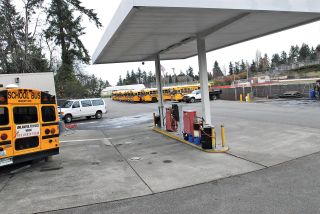District to study feasibility of new location for school transportation
By Elizabeth Celms
Mercer Island Reporter
The Mercer Island School District, after years of conversation on the topic, is ready to negotiate a plan with the city to find a new parking location for its 36 school buses. The buses are currently kept in a lot between the district administration building and the Mercer Island High School football field.
At a meeting last week, the Mercer Island School Board decided that it was due time to move the school buses to a location that would be “less of an eyesore,” according to Liz Dodd, Associate Superintendent of Business Services. Administrators proposed asking the city whether it would be willing to share its own parking and maintenance facility, currently located behind City Hall.
“We met to discuss a feasibility study on available city land for the joint parking of our vehicles,” Dodd clarified. “The [current location] has always been an eyesore — right in the middle of campus, in a residential area.”
The subject was most recently brought to public attention during forums held on the PEAK project, a youth activities center set for construction in 2008 on the North Mercer Campus. One of the most vocalized issues among the community was the potential increase of parking and traffic congestion in the neighborhood. Questions over what would happen to the current bus lot, and whether it would be moved to alleviate traffic in the area, were also brought to the School Board’s attention.
“There are 36 buses coming and leaving two times a day through the neighborhood,” Dodd said. “So I’m sure neighbors would be thrilled if we found another spot.”
Although no official negotiations have yet been held, the School Board hopes to share the city’s parking and maintenance facility behind City Hall. Presently, MISD sends its buses to Bellevue for maintenance. The district does, however, share its fuel tanks with the city, according to Dodd.
“For a long time, there have been conversations between the city and the district to use their shop facilities for maintenance,” she said, adding that MISD was ready to take the next step.
City Manager Rich Conrad agreed that this was a realistic possibility, although no official timeline has yet been established for the project. Such initiative, he added, falls upon the district.
“The school district needs to champion this idea, and we are going to go with a pace that they’re comfortable with,” the city manager said.
Conrad was an active participant in dialogue between the city, the School Board and the Boys and Girls club during the PEAK negotiations. The bus relocation question was eventually put aside in lieu of more pressing PEAK concerns, he said. It was only recently when the district revived the issue, and this time with clear intent.
Yet there are plenty of obstacles to address before plans for a joint parking facility behind City Hall — the most realistic location — can begin, Conrad said.
“The first, most serious issue is having enough land. It is very likely that we will have to purchase land. And how do we pay for this?” he questioned. “The second hurdle is that we have to develop the land. It’s not designed for school buses, so there are some modifications needed.”
Dodd said the next step would be to conduct a feasibility study on the lot behind City Hall in order to determine how much it would cost to facilitate 36 extra buses. The area would need significant reconstruction: The lot, which includes a wetlands belt, would have to be gradiated, and parking and maintenance facilities would need to be redesigned, as would access to the lot, since buses require a wide turning radius.
The city, Dodd added, has agreed to go ahead with the plan as long as the district pays for the feasibility study, which will cost anywhere from $30,000 to $50,000. The district would have to dip into its capital reserve to finance the study, Dodd said.
After hearing this, the School Board asked if they could have more time to decide whether or not to proceed with the feasibility study. John DeVleming pointed out that the benefits of relocating the buses would have to be worth the $50,000.
“What could we do with that plot of land [the current bus parking lot]?” asked Interim Superintendent Gary Plano. “Could we possibly turn that into a softball field? What are the possibilities there?”
Dodd replied that there were a number of possibilities being considered, although they come with a price. She pointed out that removing the lot’s fuel tanks would be especially costly for the district.
Community member Brian Daniels stood up to voice his support for the idea. “I think this is definitely worth looking into,” he said. “Moving those buses would be a huge benefit for the neighborhood, to relieve noise and congestion, and we could turn that land into parking or campus landscape.”
The board agreed to wait until its next regular meeting, scheduled for Dec. 13, to vote on whether or not to go ahead with the $50,000 feasibility study.
“Right now, I’m asking if we want to go down this road,” Dodd said. “And then, the possibilities can be explored.”


